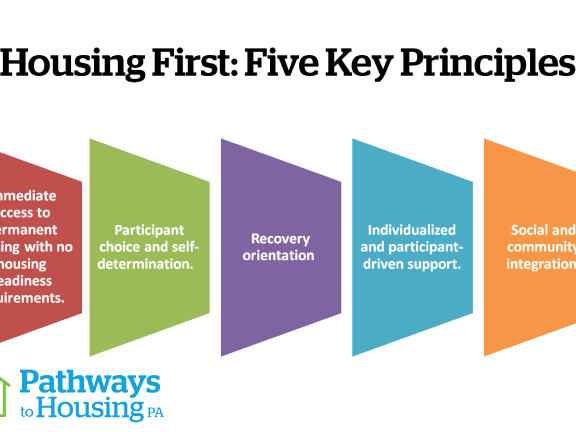Housing First is More than a Buzzword

In systems of care for people who experiencing homelessness, Housing First has achieved buzzword status.
More and more housing organizations are adopting the term to describe their work towards ending homelessness. And most of these organizations don’t understand that Housing First is the name for a documented, evidence-based model of programming that was developed to support a very specific population.
We get it – the very basic concept that everyone deserves a place to call home is easy to understand, and confusing that concept with the term Housing First is forgivable. But the overuse of the term is diluting the principles that are what makes the model successful.
So, let’s talk about what Housing First is not.
- Housing First is not emergency shelter. Housing First’s first principle is immediate access to permanent housing, with no readiness conditions. Emergency shelter is not permanent. It’s a temporary solution while a person works towards permanent housing.
Removing barriers to emergency shelter, such as removing requirements for sobriety, treatment, or identification, are a very good thing. Adjusting emergency shelter to adopt pieces of the Housing First principles will only ensure that more people receive the help that they need. But emergency shelter is not Housing First.
- Housing First is not a designated housing development. Housing First’s second principle is choice. Participants have the autonomy to choose which neighborhood, which apartment, which street they want to live on.
Housing First employs a scattered site model, which means that participants are in homes of their choosing across the region or city they’re in, rather than all together in one building. Those that experience chronic homelessness are often without autonomy and choice for years or even decades; restoring that self-determination is a key principle of Housing First. Choice does not end with the decision of where to live; it continues into every aspect of the participant’s life. Case managers offer support and encouragement, but Housing First participants have complete autonomy over how they want to live their lives.
- Housing First is does not require treatment or abstinence. The third Housing First principle is a recovery orientation, which refers to the employment of harm reduction principles as a means of promoting individualized wellness in the program design.
Essentially, harm reduction is the pragmatic acceptance that substance use and mental illness are a part of some people’s lives. Rather than ignoring or condemning, case managers work with a participant to reduce the harm they could potentially do to themselves and others. Recovery does not always translate to abstinence or medication, and is different for everyone. Housing First promotes recovery in all of its various forms, without requirements.
- Housing First is not one size fits all. The fourth principle of Housing First is individualized and person-driven supports. A multi-disciplinary team of staff provide wrap-around services to each participant, and focuses on that specific person’s needs and wants. These services include housing, clinical, and life skills supports.
Every person is different, and Housing First programs work with participants to identify their own individual goals and successes. It’s up to the participant how much involvement and support they require from their team and they have the autonomy to make their own decisions – not the decisions that others may want for them.
- Housing First does not isolate. Housing First’s fifth and final principle is social and community integration. Housing First is not housing only; housing exclusively on its own may not be enough to support a person transitioning out of long term homelessness.
It is one thing to live in a community, and quite another to be a part of a community. Housing First helps participants live in the community of their choice and be valued for their own uniqueness and abilities, just like everyone else.
Housing is separate from support services, and clients are not stigmatized or isolated. Opportunities for social and cultural engagement are supported through employment, volunteer, and recreational activities.
Many claim to use a Housing First model in their work, but few actually employ all five of the principles listed here. And those who are using one or a few of these principles, without implementing the full evidence-based model, are wondering why they’re not seeing the success rates that those who employ a high fidelity version of the model are seeing.
Pathways to Housing PA was founded in 2008 based on the model developed by Sam Tsemberis, who founded Pathways to Housing in New York City and coined the term Housing First to describe the housing model he developed to support people with mental health disabilities that have experienced chronic homelessness.
In our eleven years of operation, we’ve held a consistent 85% housing retention rate for Housing First participants after five years in the program. Given that we are working with individuals who are considered not housing ready by other programs, our housing retention rate for more than 450 current participants is excellent.
In addition, we were the first to utilize the Housing First model specifically for people with opioid use disorder (OUD) who have experienced homelessness to combat the effects of the opioid crisis. In the three years since we launched that program, the housing retention rate for this sub-population has remained consistent with the rate for our other participants. In addition, more than 65% of those with OUD are seeking treatment within the first six months of being housed; nationwide only 20% of the general population with OUD are seeking treatment.
Housing First is a best practice, but only when the model is employed in full. It’s important that those who are providing housing services demonstrate fidelity to the principles of the model before calling their programming Housing First.


